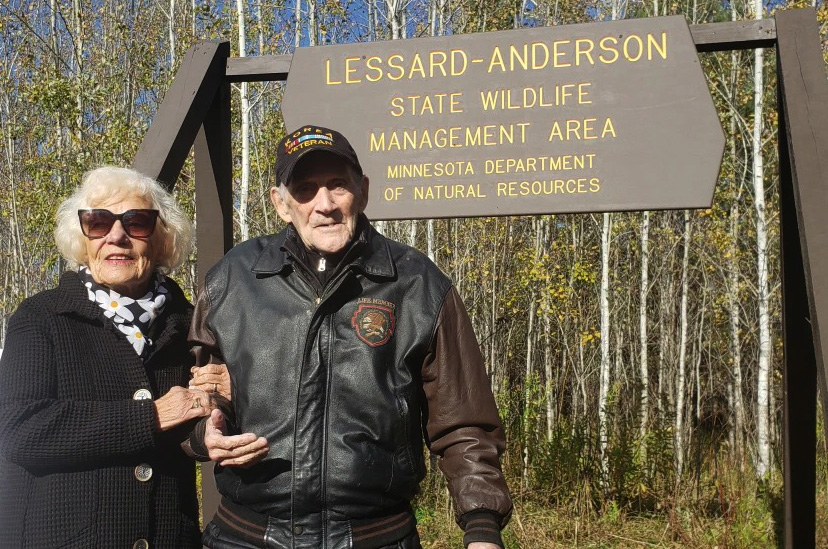Last Monday – a crisp, sunny day in all of its October glory – was a celebration of public lands and their importance to all of us who spend time outdoors.
The day started by meeting up with Kristi Coughlon, an information officer for the Minnesota Department of Natural Resources in Bemidji, and her hunting dogs Cokie and Bennett.
Cokie, a yellow Lab, is named after Cokie Roberts, the American journalist, author and commentator who died in 2019; Bennett, a griffon, is so-named for Detective Joan Bennett from the “Bosch” TV crime series.
Kristi Coughlon, an information officer for the Minnesota Department of Natural Resources in Bemidji, Minn., fastens a bell onto the collar of Cokie, her yellow Lab, on Monday, Oct. 6, 2025, before a morning grouse hunt on a Hunter Walking Trail in the Beltrami Island State Forest. (Brad Dokken / Forum News Service)
The first leg of this October celebration brought us to a couple of Hunter Walking Trails in Beltrami Island State Forest to try to flush up a ruffed grouse or two. The second leg – and the real reason for our Northwoods rendezvous – was to venture even farther east to mark the dedication of a new wildlife management area along the Rainy River between Baudette and International Falls, Minn.
The 280-acre Lessard-Anderson State Wildlife Management Area is named after former state Sen. Bob Lessard of International Falls and Bob Anderson, former mayor of “The Falls,” who died unexpectedly in 2019. Good friends, the two men were leaders in northern Minnesota conservation circles. Lessard played a vital role in passing the legislation that created the Clean Water Land and Legacy Amendment, which Minnesota voters approved in November 2008 to provide dedicated funding for fish and wildlife habitat, parks and trails and the arts. Anderson served as chairman of the Lessard Sams Outdoor Heritage Council, which allocates Legacy Amendment dollars through the Outdoor Heritage Fund.
The new WMA, just off State Highway 11 about 35 miles west of International Falls, includes 1.6 miles of Rainy River shoreline that is now available for public use and wildlife habitat.
Pheasants Forever purchased the land for $800,000 from the Molpus Woodlands Group, which managed the site, and sold it to the DNR to establish the WMA.
Critics might wonder why an outdoors writer from Grand Forks, N.D., ventures all the way over to the Rainy River to attend the dedication of a wildlife management area. Fair question, that, but the main reason was to pay tribute to Lessard, now 94, who was on hand for the celebration, attended by upwards of 50 people.
I’ve known Lessard for years, first during his tenure in the Minnesota Legislature, while writing stories about such issues as wolf management, right to hunt and fish legislation (which he also spearheaded) and dedicated outdoors funding.
More recently, I’ve fished with Lessard at his camp on Otukamamoan (Trout) Lake in northwestern Ontario on a number of occasions. He guided right up until his late 80s and still spends summers at the camp with his son Brett, who now oversees the place.
It seemed only fitting that I make the trip to pay tribute to a man I also consider a friend.
Plus, you can do a lot worse than a crisp October day in northern Minnesota.
The Hunter Walking Trails that Coughlon and I explored to start the day were new to both of us, but we didn’t have to worry about trespassing or being somewhere we weren’t supposed to be. The trails were signed and mowed and offered what looked like good ruffed grouse habitat.
The birds apparently thought so, too. Even though we didn’t end the morning with any birds in the bag, we flushed one ruffie (and may have heard another) on the first trail and flushed five more birds on the second.
For the first time all year, the woods actually smelled like fall. To me, the earthy aroma of decaying leaves is the smell of October.
The dedication, which didn’t start until 4 p.m., included representatives from Pheasants Forever, the Minnesota DNR, the Minnesota Deer Hunters Association and other partners. Lessard and Anderson’s wife, Carol, along with other members of their families, also attended.
Sabin Adams, Minnesota state coordinator for Pheasants Forever and Quail Forever, said people might wonder why Pheasants Forever is involved with a project in northern Minnesota, where there are no pheasants, but the conservation group’s mission statement says “we conserve pheasants and other wildlife,” he said.
The Reinvest in Minnesota (RIM) program, which provides state funding for conservation work, also played a key role, Adams said.
“Pheasants Forever buys this property, (and) the Minnesota DNR then buys it from Pheasants Forever,” Adams said. “Well, where did this all come from? If you look around at all the license plates on all the vehicles in here, there’s a whole bunch of them that have a loon, a pheasant, a deer, etc.
Related Articles
Minnesota artist James Hautman wins 2025 Federal Duck Stamp Art Contest
Accessible deer hunt at Rydell National Wildlife Refuge marks 30-year milestone
Continental duck numbers hold steady, feds say in status report
Motorist shot in leg on I-35 in Chisago County; cops heard target shooting nearby
DNR rejects calls to halt hunting dog training at Keystone Woods
“That’s your RIM dollars at work supporting this effort, and so we used those RIM funds with the Minnesota DNR to purchase this property and make it happen. This didn’t just happen because of Pheasants Forever and the Minnesota DNR, it happened because the citizens of Minnesota care about this sort of thing.”
As a result, everyone now has access to 1.6 miles of riverfront property along the Rainy River. That, in itself, is remarkable.
So it went on a crisp day in October, a day of enjoying – and celebrating – public lands.


Leave a Reply